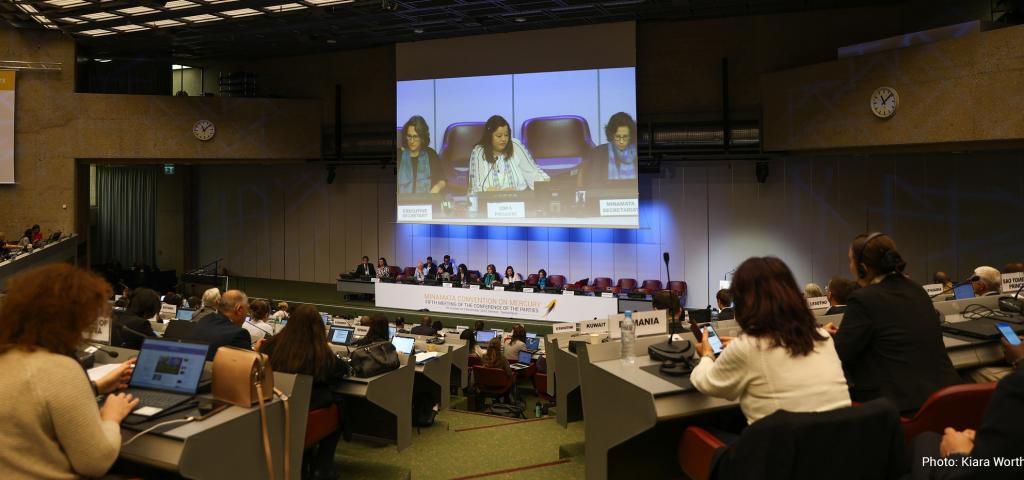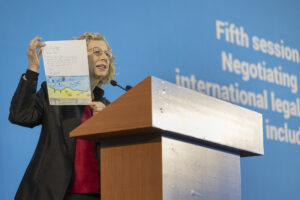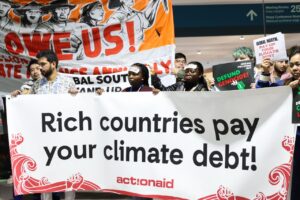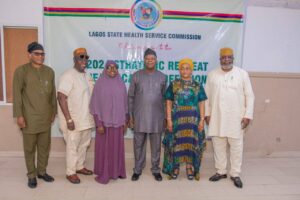
With more than 800 participants and 900 online viewers, the fifth meeting of the Conference of the Parties to the Minamata Convention (COP-5), held in Geneva from 30 October to 3 November 2023, made significant progress by adopting 21 decisions to keep protecting human health and the environment from the harmful effects of mercury.
In her closing remarks, the outgoing COP President, Claudia-Sorina Dumitru, thanked all participants and the Secretariat of the Convention for their hard work during the week: “We really have an obligation to contribute to ensuring the health and well-being of our future generations by reducing human exposure to mercury. Let’s not forget that we are here to make mercury history”, she highlighted.
Executive Secretary of the Minamata Convention, Monika Stankiewicz, congratulated the COP-5 President on her constructive spirit and thanked all delegates for their accomplishments. “You have achieved something extraordinary at this COP. You have truly come from across the world to show and reaffirm your strong commitment to reaching the objective of the Minamata Convention”, she stated. “I thank and congratulate all Parties for breathing new life into this living Convention”.
In its first decision, the COP noted the importance of broadening the participation of Indigenous Peoples, as well as local communities, in the implementation of projects and programmes undertaken under the Convention, recalling the relevance of their engagement in the work to reduce and eliminate mercury use in artisanal and small-scale gold mining (ASGM). In a separate decision on ASGM, the COP encouraged Parties and stakeholders to protect and strengthen traditional livelihoods and cultural practices and called for further actions in the development and implementation of National Action Plans.
For the second time, the Parties decided to amend Annex A to the Convention with new phase-out dates for certain batteries, switches, relays and fluorescent lamps. Parties agreed on a new requirement to advance the phase-down of dental amalgam and, as of 2025, no mercury level will be allowed in cosmetics. They also decided to amend Annex B with a 2025 phase-out date for the production of polyurethane using mercury catalysts. Parties worked based on amendment proposals from the Africa region and mandates from COP-4 to achieve these results and agreed to consider further measures on dental amalgam at COP-6.
Other technical decisions covered the adoption of guidance for controlling mercury releases to land and water, and the request for Parties to continue to advance their efforts to control the emissions of mercury to the atmosphere. After seven years of negotiation, the Parties agreed on a 15 mg/kg total concentration of mercury as the threshold for wastes contaminated with mercury or mercury compounds, inviting submissions of scientific and regulatory information on this topic.
The COP established a group to oversee the development of the first report to evaluate the effectiveness of the Convention, following the agreed indicators, most of them based on national reporting submissions. Considered a standalone agenda item for the first time, the COP pushed to reduce mercury supply sources and trade by strengthening capacities at the national level and developing a study on the global supply, trade, production and use of mercury compounds.
Another milestone was the completion of the second review of the Convention’s financial mechanism and the adoption of a decision underscoring the need for further strengthening of capacity-building, technical assistance and technology transfer, with a particular focus on alternative technologies and meeting the specific needs of developing country Parties and Parties with economies in transition. Delegates unanimously adopted a gender action plan, and a digital strategy to guide the work of the Secretariat in the upcoming years.
Considering the recommendations of the Implementation and Compliance Committee arising from the first full national reports, submitted by 95% of Parties, the COP adopted amendments to the national reporting format and updates to its guidance to better detail the measures taken to implement the Convention.
A multitude of partner organizations and observers highlighted their efforts aimed at strengthening collaboration with the Convention. The COP welcomed the opportunity for the Secretariat to become an observer at the meetings of the UN Climate Change Conferences and welcomed the recent adoption of the Global Framework on Chemicals, requesting the Secretariat to further collaborate with relevant bodies in recognition of the collective commitment to addressing chemical and waste-related challenges on a broad political scale.
Taking into account that the recent adoption of the Kunming-Montreal Global Biodiversity Framework was a major milestone for the world and the Minamata Convention, the COP encouraged Parties to take a number of steps to advance integrated action on mercury reduction and biodiversity, and invited the Conference of the Parties to the Convention on Biological Diversity to consider additional indicators, under Target 7, to cover highly hazardous chemicals and mercury.
During the week, COP-5 featured various activities in coordination with the Geneva Environment Network, including the screening of the Minamata movie, a special event reflecting on the Convention’s tenth anniversary since its adoption, and discussions on harmful skin-lightening practices. Participants had opportunities for information exchange and networking through knowledge labs, and partner institutions showcased their projects in the exhibition area.
Delegates showed a great spirit of commitment to complete the ambitious agenda for the week. With 21 decisions adopted, this is a testament to their willingness to make rapid progress on addressing mercury pollution.
The next meeting of the Conference of the Parties to the Minamata Convention (COP-6) will convene in Geneva from 3 to 7 November 2025 under the Chilean presidency. Until then, all stakeholders stand ready to continue engaging during the intersessional period to keep making mercury history.
Looking forward to the work ahead for the next two years, Osvaldo Patricio Álvarez Pérez, COP-6 President, stated that “our ambition is to make a noticeable difference, to effect real change, and to leave the legacy of a healthier, safer planet”.







